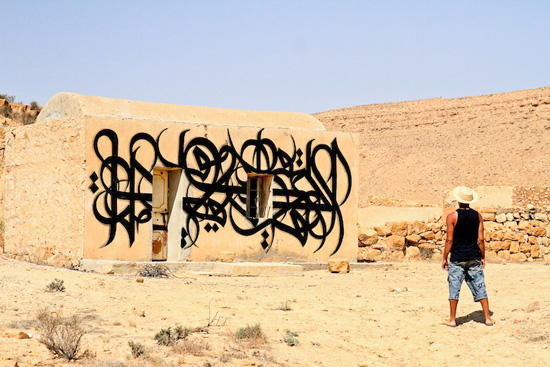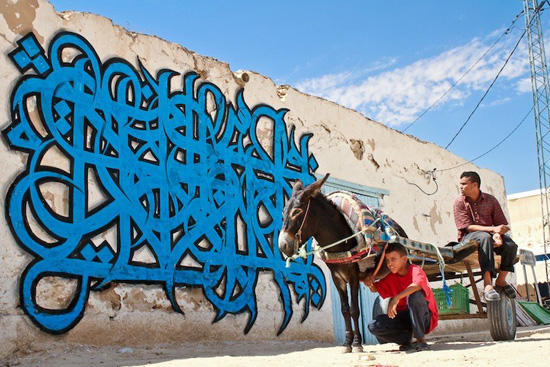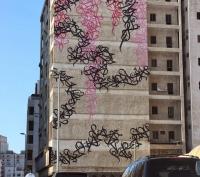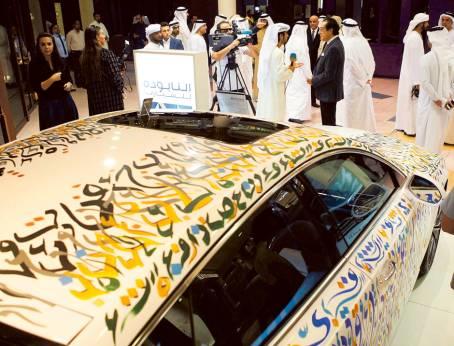Arabic calligraphy (Islamic calligraphy) is a form of art involving the use of the Arabic language and alphabet. Arabic calligraphy emanated from the Arabic word, that (خط), which refers to construction or design (Widany, 2011). Islam, unlike other religions, did not rely on figural images to pass their major conviction to faithful. Instead, the religion relied on various shapes and sizes of letters and/or words to convey such messages. Islamic religious leaders believed that figural arts could reflect some elements of idolatry. As such, they turned to artistic calligraphy to express religious beliefs. Consequently, Arabic cultures, as observed in Islamic, focused on promoting calligraphy as the most valuable form of art – writing art.
Arabic calligraphy is the main type of art for Islamic visual expression, creativity, and presentation. In the extended history of the Islamic region, Arabic calligraphy has been associated with beauty, power, and unity (Mubireek, 2000, p. 1). Arabic calligraphy reflects some elements of aesthetic works, which generally capture the cultural values and practices of the Islam community. As such, scholars and artists have explored Arabic calligraphy from historical perspectives to capture its evolution and allow the public to learn about art. In this research paper, Arabic calligraphy is explored to reflect its popularity in Saudi Arabia wall streets, latest applications, and most prominent calligraphy artists associated with it.
As previously noted, Arabic calligraphy holds a special place in the Islamic world. It is considered as artistic and spiritual art that reflects the unity, power, and beauty of Islam. According to the latest observations on the origin and evolution of calligraphy, Arabic calligraphy is slowly making its way into secular art now common in the Gulf region, especially in Saudi Arabia. Walls along major streets have provided the perfect space for expressing this form of art. While the calligraphy may just be emerging and gaining recognition into the mainstream secular world of art, the walls of Saudi Arabia have provided the best place for innovation and development of Arabic calligraphy.
Today, contemporary calligraphy artists, such as el Seed and Ous Ghazzal among others, have created a new form of Arabic calligraphy referred to as ‘calligraffiti. Today, many young artists have identified with calligraffiti. It is now responsible for a large number of young artists decorating the walls of Saudi Arabia with calligraphy arts.

Artists rely on walls to express Arabic calligraphy designs. Notably, some artists have used such walls to convey political messages. Saudi calligraphy artists have used walls to explore various forms of calligraphy art. They have presented complex and detailed forms of Arabic calligraphy on walls. In the old town of Jeddah (Al Balad), for instance, artists have blended Arabic calligraphy with graffiti to create calligraffiti (McClellan, 2012).
As many young people identify with calligraffiti, they encounter multiple challenges. They struggle to gain recognition by society in the Kingdom. Many older people are yet to embrace graffiti, and they consider it a form of public bother, vandalism and not an emerging form of art (Al-Mansouri, 2014, p. 1).
Arabic calligraphy artists are nomadic. As such, their works are mainly influenced by local contexts and challenges (Al-Mansouri, 2014). Apart from walls along Saudi streets, some local Saudi artists, such as Ous Ghazzal, work with many other young Saudi artists to decorate cars, but with distinct Arabic letters augmented with intricate graffiti approaches, colors, and techniques.
It is currently observed that many Saudi calligraffiti artists are not prepared for mainstream work. Instead, they want to adapt gradually in a conservative society in which the public may view such artistic expression with contempt.
Calligraffiti has been generally associated with political protest messages. However, in some instances, Arabic calligraphy is applied in the design of various products, including the human body. To some artists, calligraffiti is a form of sport, competition, and arts done for personal gratification and identification. Today, Arabic calligraphy artists, such as Bilal Khaled based in Pakistan, have focused on decorating other items, including cars, street walls, handbags, and human bodies. Fashion and design will present the next opportunity for the artist to explore Arabic calligraphy.
For body art, it works perfectly. The artists believe that the Arabic script portrays physical strength and, thus, it complements physical strength sought by bodybuilders. While bodybuilders’ Arabic calligraphy art is gaining popularity, like any other form of calligraphy, it is yet to be acknowledged by society. Khaled laments that some people consider such art as skin tattoos. Skin tattoos are however prohibited in Islam. The artist asserts that the work is temporary writing that can be washed away and therefore not a tattoo.

Other artists, such as Tarek Atrissi, Josh Berber and others, have found many ways to commercialize their expertise. For instance, they also use Arabic calligraphy on commercials, weddings, and papers as well as tattoos. For instance, Atrissi concentrates on branding and bilingual typography. That is, the artist has developed unique techniques that entail cross-cultural graphic designs by using Arabic calligraphy and exhibition design.
The artist claims that his corporate clients include Apple Inc., the BBC, the Mathaf Arab Museum of Modern Art in Qatar, the V&A museum in London, and the Arab Thought Foundation (Atrissi, n.d). Atrissi is credited by using his style of calligraphy to design the visual identity of Qatar in 2004. He also claims design projects for well-known international brands, such as L’Oreal and Estee Lauder. Also, the artist has worked for other small startups and not-for-profit organizations. Some of his major works can only be found with customized Arabic and multilingual typefaces for many firms in Arab nations. Besides, Atrissi worked as a creative director in Germany and consulted for big corporations.
Arabic calligraphic and the so-called calligraffiti have gained much recognition in marketing. For instance, graffiti artwork has been successfully used to market a new mobile phone, according to a Saudi graffiti artist, Deyaa Rambo.

In the Kingdom, many calligraffiti professionals are not prepared to join the general calligraffiti field. However, the situation is different for some renowned Arabic calligraphy artists. Such artists have gained global or regional recognition based on their works. It is imperative to recognize that Arabic calligraphy has evolved from its classical origin to contemporary status. These changes reflect a successful breakthrough for the representation of the culture and calligraphy art for artists globally (Mehbub, n.d). Over time, calligraphy artists have perfected their works and have been able to appeal to the audience globally.
Haji Noor Deen Mi Guang Jiang has established himself as an Arabic calligraphy professional. With Chinese background, Jiang has combined rich traditions with Islamic art to appeal to a contemporary audience. He applies self-developed calligraphic style through a unique fusion of Islamic art and Chinese calligraphic traditions to link some two forms known for the expressive manifestation of the letters and symbols. These two distinct styles of writing from different cultures generally complement each resulting in an appealing artistic work that is unique, aesthetically appealing while reflecting the artist’s genius. Jiang’s exceptional genius and mastery of Arabic calligraphy have earned him a reputation in some of the most prestigious institutions, including Harvard University, MIT, and Berkley University California among others (Deen, n.d). Jiang wants to promote Arabic calligraphy by establishing his academy in China.
Karim Jabbari also brings a unique talent to Arabic calligraphy. He is known as a light calligraphy artist because of constant innovation and developing new ways of utilizing Arabic calligraphy in different ways (Jabbari, n.d). Karim developed his style of Arabic calligraphy by relying on the old Arabic calligraphy for guidance. The artist uses various colors, shapes, and patterns to develop original concepts. As such, the Karim is responsible for the evolution and emerging forms of Arabic calligraphy. The artist has gained recognition because of Maghrebi and classic Kufi calligraphy works while ensuring that Arabic calligraphy tradition remains active.
eL Seed is the Arabic calligraphy artist associated with the so-called calligraffiti. As noted above, the artist blends the modern form of graffiti art and Arabic calligraphy while incorporating street cultures to develop appealing works (Seed, 2013). eL Seed has mastered various cultures, languages, and identities because of his background in Paris. As such, like Jiang, Seed strives to combine two cultures into one using calligraffiti. Consequently, eL Seed has established a unique identity, distinct styles, and mark in Arabic calligraphy. The artist wanted to do 3-D works and found the right facilities to achieve this goal. Through the 3-D approach, eL Seed wants to ‘free’ letters from the 2-D surface on the wall to allow the audience to engage with calligraphy and immerse themselves into the message of the artist.
eL Seed relies on complex composition of words and their meanings in his works to create movements that transform the audience’s perception. The artist uses contradictory elements to depict the reality of life, humankind, and the world. eL Seed observes that it is not simple to change from graffiti styles to Arabic calligraphy. Further, the artist claims that his works aim to break the stereotype. For instance, gold, black, and silver are the major colors associated with Arabic calligraphy. However, eL Seed has often used a shade of pink as his signature color to break the color stereotype (Kalsi, 2014). The artist adds that calligraphy is an abstract form of art that appeals to everyone irrespective of language and/or culture. It goes beyond the eye to the soul and, therefore, the audience who cannot read emotionally connects with the message. eL Seed notes that his calligraffiti is all about emotions and making streets beautiful.

Hand motions are vital for all emerging calligraphy artists (Berber, n.d). Further, artists have mastered the flow of letters to produce almost perfect graffiti. While they strive for mastery and perfection, artists will continue to learn new unique styles to develop their arts. No specific skills and levels of adeptness can replace the need for further efforts and the need to learn new ways of calligraphy because artists never actually reach the peak of their craft. There is always room for improvement.
Saudi calligraffiti artists are reluctant to go mainstream perhaps because of the conservative society in which they conduct their affairs. Conversely, other artists, specifically the above-mentioned ones, have gained international recognition. Nevertheless, some Saudi calligraphy artists, such as Ghazzal, have received an international invitation to present their graphic design projects in Paris. However, Saudi calligraphy artists decry a lack of support and assistance from branch municipalities, mayoralty, and the chamber of commerce and industry. It was not possible to reach any relevant officials. No serious efforts are being offered to calligraphy artists in Saudi at all.
The 8th International Arabic Calligraphy Exhibition was held in Dubai. The collection reflected the aesthetic aspects of every Arabic language used. It was an opportunity for the audience to learn about history, trends, and cultural relevance of Arabic calligraphy (Achkhanian, 2015).
It is imperative to note that street cultures often shape calligraffiti, particularly among artists who identify with graffiti, hip-hop, and break dancing. Also, most successful Arabic calligraphy artists have interacted with more than one culture as shown in cases of Jiang, eL Seed, Karim, and Tarek Atrissi among others. This implies that the Kingdom could be stifling Arabic calligraphy development because of strict rules associated with the religion. Therefore, such artists can develop their styles by combining Western-style graffiti and Arabic calligraphy.
Calligraffiti artists refer to themselves as street artists who work on different walls in diverse locations and then leave. Artists, however, recognize that their works on walls will always stay with local communities. Hence, Arabic calligraphy artists strive to select words that are relevant to local people. Nevertheless, Arabic calligraphy artists often strive for works with universal appeal. They see art as a means of building bridges and opening conversations with the audience. For instance, in Tunisia, eL Seed created the largest murals with the message of tolerance and unity. In Brazil and Saudi Arabia, the artist was inspired by words from poems to convey specific messages related to local contexts.
Arabic calligraphy artists have better chances of developing their works to appeal to an international audience through exhibitions, which feature both traditional and contemporary types of calligraphy by artists with different backgrounds.

The research paper has explored Arabic calligraphy, its growing popularity in Saudi Arabia, application for various roles, famous artists, and international recognition. It shows that Arabic calligraphy has its foundation in the Islamic religion. Over the years, Arabic calligraphy has evolved from traditional approaches to contemporary ones, including the so-called calligraffiti. Artists have developed their unique styles without any rules to find the application of Arabic calligraphy in a wide range of cases, including tattoos. Overall, Arabic calligraphy will continue to evolve and take new shapes as more young people join the art in the Kingdom and other locations globally. Such young artists require support from all stakeholders.
References
Achkhanian, M. (2015). Arabic calligraphy brought to life in Wafi Mall. Gulf News. Web.
Al-Mansouri, A. (2014). The power of single letter graffiti in Saudi Arabia. Saudi Gazette. Web.
Atrissi, T. (n.d). Tarek Atrissi Design. Web.
Berer, J. (n.d). Josh Berer: Arabic calligraphy Design. Web.
Deen, H. N. (n.d). Haji Noor Deen Mi Guang Jiang. Web.
Jabbari, K. (n.d). Artist Karim Jabbari. Web.
Kalsi, J. (2014). Street artist puts up 3D calligraffiti show. Gulf News. Web.
McClellan, M. (2012). Where art blends with activism. Harvard Gazette. Web.
Mehbub, H. (n.d). Showcase of Inspiring Arabic Calligraphy Artworks. Web.
Mubireek, K. (2000). Arabic Calligraphy. Web.
Seed, e. (2013). eL Seed. Web.
Widany, S. (2011). The History of Arabic Calligraphy – An Essay on Its Greatest Artists and Its Development. München: GRIN Verlag. Web.